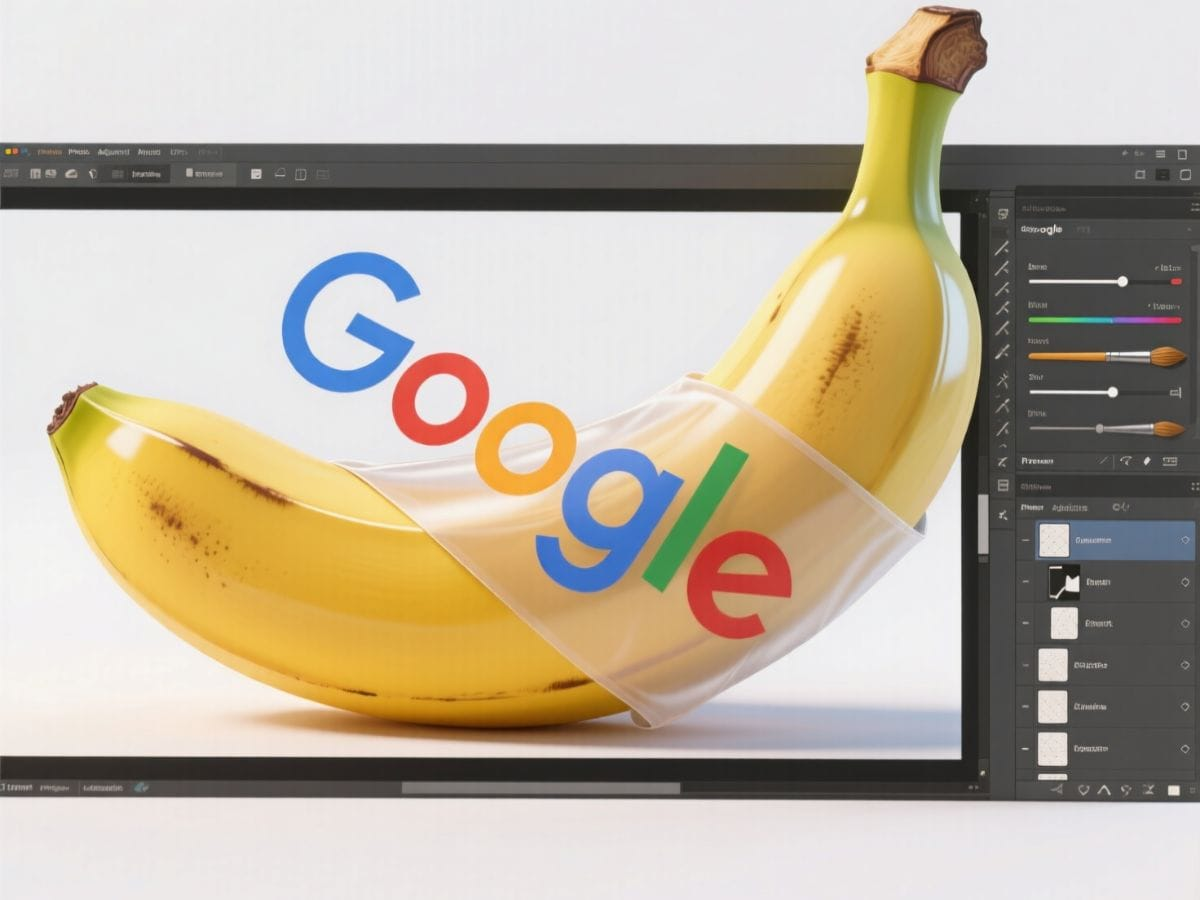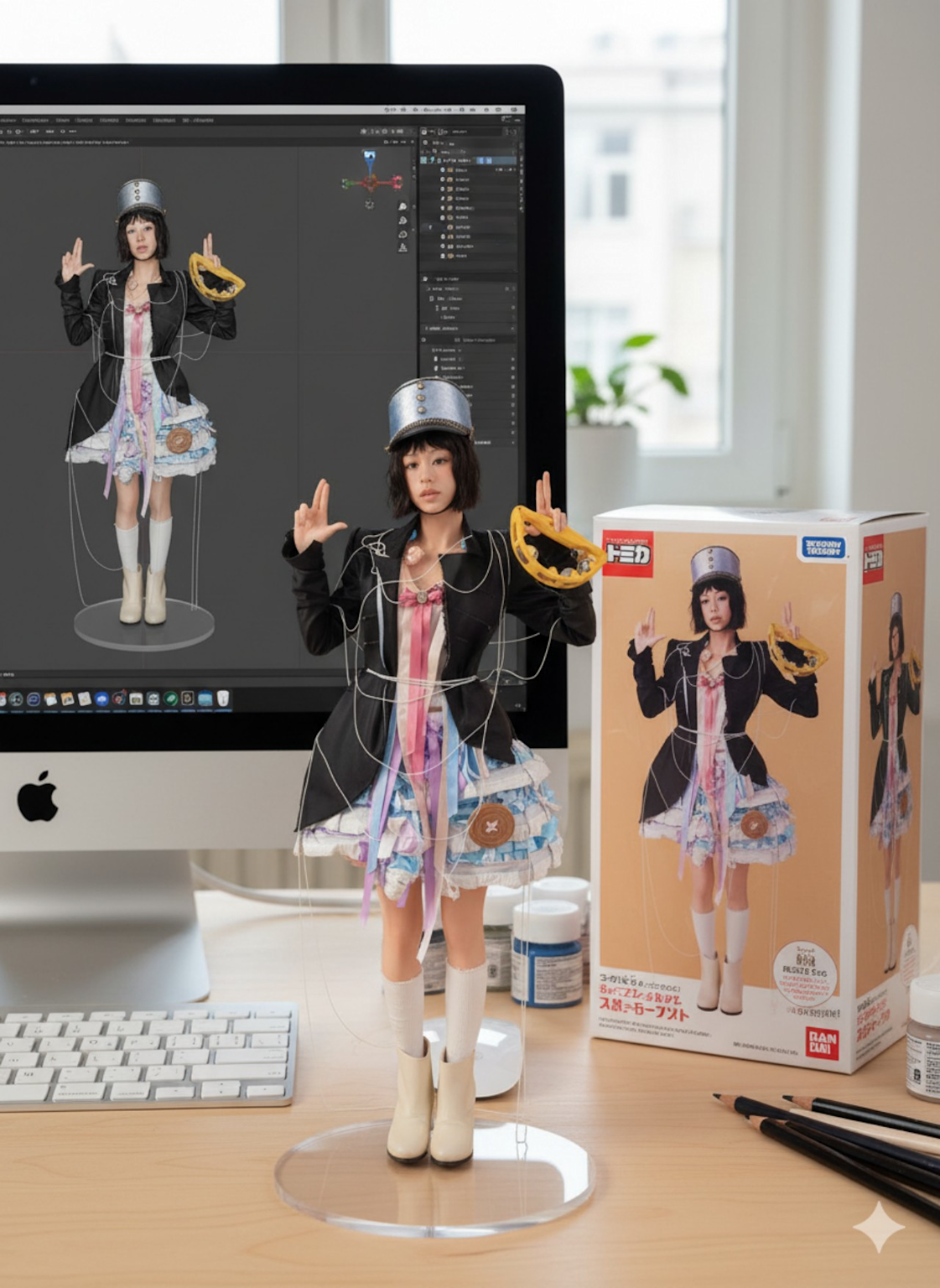Google has unleashed a powerful new AI image editing tool that has rapidly become a global phenomenon. Nano Banana, officially known as Gemini 2.5 Flash Image, represents Google DeepMind’s latest advancement in conversational image generation and editing, transforming how people create and modify digital images. Within weeks of its launch, this tool has processed over 500 million images, propelled Google’s Gemini app to the top of app store charts, and sparked viral social media trends worldwide.
The technology represents a significant leap forward in AI-powered image editing, offering capabilities that were previously exclusive to professional software like Adobe Photoshop. What sets Nano Banana apart is its ability to understand natural language commands, maintain subject consistency across edits, and blend multiple images seamlessly—all through simple conversational prompts rather than complex technical interfaces.
Nano Banana and Gemini branding for an AI-based image creation tutorial called Image Creation Hacks

Technical Capabilities and Architecture
Core Technology Foundation
Nano Banana is built on Google’s Gemini 2.5 Flash Image model, which features a sparse mixture-of-experts (MoE) architecture with native multimodal support. This advanced system processes text, images, audio, and video within a unified framework, enabling sophisticated understanding of both visual and textual inputs. The model supports a 1-million-token context window and can handle up to 3,000 images per prompt with a maximum file size of 7MB per image.
The architecture incorporates SynthID watermarking technology, embedding both visible and invisible markers in generated content to ensure AI-generated images are properly identified. This transparency measure addresses growing concerns about AI-generated content authenticity while maintaining the tool’s creative capabilities.
Advanced Image Understanding
Unlike traditional image generators that focus primarily on creation from scratch, Nano Banana excels at intelligent image editing. The system demonstrates sophisticated understanding of spatial relationships, lighting conditions, and object interactions within photographs. It can perform complex transformations while preserving the original image’s context, mood, and photographic qualities.
The model’s world knowledge integration allows it to generate contextually accurate edits based on real-world understanding. For example, when asked to place a subject in Paris, it accurately renders the Eiffel Tower with appropriate architectural details and surrounding urban elements. This semantic understanding extends beyond simple visual pattern matching to include cultural, geographical, and historical accuracy.
Multi-Modal Processing Capabilities
Nano Banana’s native multimodal architecture enables several groundbreaking features:
Character Consistency Preservation: The system maintains facial features, expressions, and physical characteristics across multiple edits, ensuring that subjects remain recognizably themselves throughout transformation processes.
Multi-Image Fusion: Users can upload multiple photographs and seamlessly blend elements from different sources into cohesive final images. This capability enables complex compositions like placing products in lifestyle settings or combining portraits with different backgrounds.
Iterative Conversational Editing: The tool supports multi-turn editing sessions where users can refine images through sequential prompts, building upon previous modifications while maintaining visual coherence.
Women showcasing various saree styles in vibrant colors, possibly illustrating AI-enhanced fashion transformations in the Nano Banana AI saree trend

Accessing and Using Nano Banana
Platform Availability
Nano Banana is accessible through multiple Google platforms, making it widely available to both casual users and developers. Consumer access is provided through the Gemini app, available on both web browsers and mobile devices for iOS and Android. Users simply need a Google account to begin creating and editing images.
Developer access is available through the Gemini API and Google AI Studio, with pricing set at $30 per 1 million output tokens (approximately $0.039 per image). Enterprise users can access the technology through Vertex AI for commercial applications.
Usage Limits and Pricing Tiers
The democratization of AI image editing comes with structured usage limits designed to manage server demand while providing accessible entry points:
Free Tier: Users can generate or edit up to 100 images daily, providing substantial access for personal use and experimentation.
Pro and Ultra Subscriptions: Paid subscribers receive priority processing and can generate or edit up to 1,000 images daily, along with higher-quality outputs and faster processing times.
These limits have been dynamically adjusted based on server capacity and demand, with Google implementing temporary restrictions during peak usage periods to maintain system stability.

User Interface and Experience
The interface emphasizes natural language interaction over technical complexity. Users can describe desired changes in conversational terms rather than learning specific software commands or techniques. For example, instead of manually selecting areas and applying filters, users can simply state “make the background more dramatic” or “change her outfit to a formal dress.”
The tool supports drag-and-drop functionality for image uploads and provides real-time feedback during processing. Generated images can be downloaded in standard formats, though current resolution limits cap outputs at approximately 720p quality.
Screenshot of Google’s photo editing interface showing a banana with the Google logo edited onto it using a transparent plastic film effect
Viral Social Media Phenomena
The 3D Figurine Craze
One of Nano Banana’s most viral applications involves transforming personal photographs into hyper-realistic 3D collectible figurines.

3D figurine of Nano Banana character alongside its digital model and packaging, showing the blend of 3D design and physical action figure
Users employ specific prompts like “Create a 1/7 scale commercialized figure of the character in the photo” to generate images that appear to show professional action figures complete with packaging and display bases.
This trend has captured widespread attention because it provides instant gratification—users can see themselves as commercial collectibles within seconds. The realistic rendering quality, combined with authentic-looking packaging designs, creates compelling visual content that performs exceptionally well on social media platforms.
Cultural Fashion Transformations
The AI saree trend has become particularly popular in India and among global South Asian communities. Users upload contemporary selfies and use prompts to transform their appearance into dramatic Bollywood-style portraits featuring traditional Indian clothing. These edits often incorporate vintage aesthetic elements like film grain, warm lighting, and classic cinematographic styles reminiscent of 1990s Indian cinema.
Sample prompts include: “Convert this person into a retro vintage grainy but bright image, black party-wear saree, 90s film aesthetic… lighting is warm, with golden sunset tones evoking golden hour glow”. The trend’s popularity demonstrates Nano Banana’s cultural adaptability and its ability to understand diverse aesthetic preferences.
Nostalgic Time-Blending Effects
Another viral application involves creating temporal fusion images, such as the “Hug My Younger Self” trend. Users provide childhood photographs alongside current pictures, requesting images that show their present and past selves interacting naturally. These emotionally resonant creations have driven significant engagement across social media platforms.
The technology’s ability to maintain facial consistency while adapting for age differences showcases its sophisticated understanding of human features and temporal relationships.
Current Limitations and Challenges
Technical Performance Issues
Despite its impressive capabilities, Nano Banana faces several persistent technical challenges that affect user experience:
Quality Degradation Through Multiple Edits: Extended editing sessions often result in progressive image quality loss, with subjects’ facial features gradually drifting from their original appearance. Professional users report that complex multi-turn editing sequences can produce unusable results despite successful individual modifications.
Inconsistent Processing Results: Users frequently encounter situations where identical prompts produce significantly different outputs, making it difficult to achieve consistent results for professional applications. This unpredictability particularly affects users requiring specific aesthetic standards or brand consistency.
Processing Failures: A common frustration involves the system returning original images unchanged despite clear editing instructions. These failures occur more frequently with complex scene modifications compared to simple object-focused edits, forcing users to repeatedly attempt the same edits with varying success rates.
Resolution and Export Limitations
Current output resolution restrictions limit professional applications. Images are constrained to approximately 720p quality, which falls short of modern print media and high-resolution digital display requirements. Additionally, all outputs include watermarking that may not be suitable for commercial use without proper disclosure.
Processing Speed Variability: Response times vary significantly based on server demand and edit complexity. During peak usage periods, processing can extend beyond reasonable timeframes, disrupting professional workflows that require predictable turnaround times.
Content Understanding Gaps
While Nano Banana excels at broad scene understanding, it struggles with fine-grained detail accuracy. Text rendering remains problematic, with generated text often appearing illegible or distorted. Complex anatomical elements like hands and fingers continue to pose challenges, frequently resulting in unnatural positioning or proportions.
Object Integration Issues: When replacing objects within scenes, the tool sometimes fails to properly adjust hand positions, shadows, or spatial relationships. For example, replacing a cocktail glass with a beverage can may leave hands positioned for the original object, creating visually unconvincing results.

A collectible figurine “Gentleman’s Toast” next to its digital 3D model displayed on a computer screen, demonstrating the bridge between digital design and physical production
Competitive Landscape Analysis
Comparison with Established Tools
Nano Banana’s position in the AI image editing market reflects both significant advantages and notable limitations compared to established competitors:
Versus Adobe Photoshop AI: Traditional software maintains superior precision and professional-grade control, offering layer-based editing, advanced color correction, and pixel-perfect adjustments. However, Nano Banana provides dramatically faster results for common editing tasks and requires no technical expertise. The conversational interface democratizes advanced editing capabilities but sacrifices the granular control that professional workflows often require.
Versus Midjourney: While Midjourney excels at artistic image generation from text prompts, Nano Banana’s strength lies in editing existing photographs while maintaining subject identity. Midjourney produces highly stylized artistic outputs but lacks Nano Banana’s ability to preserve real-world photographic authenticity and subject consistency.
Versus ChatGPT Image Editing: OpenAI’s image capabilities currently focus on basic modifications and inpainting tasks. Nano Banana offers more sophisticated multi-image blending, style transfer, and complex scene modifications through its advanced multimodal architecture.
Unique Competitive Advantages
Identity Preservation Excellence: Nano Banana’s ability to maintain facial features and subject characteristics across multiple edits represents a significant technical achievement. This capability enables applications like virtual try-on experiences and character consistency in storytelling that other tools struggle to replicate.
Conversational Workflow Integration: The seamless integration with Google’s Gemini ecosystem provides a natural editing experience where users can refine images through dialogue rather than learning complex software interfaces.
Multi-Image Composition: The tool’s native ability to blend multiple source images into cohesive compositions exceeds the capabilities of many specialized editing applications.
Privacy and Safety Considerations
Data Security Concerns
The viral adoption of Nano Banana has raised important questions about data privacy and security. An Indian Police Service officer issued warnings about potential scams targeting users of AI editing trends, emphasizing the importance of using official Google platforms rather than unauthorized third-party applications that may harvest personal data.
Users have reported concerning experiences, including AI-generated images that appear to include personal details not explicitly provided in prompts. One user noted that generated images included physical characteristics like moles that weren’t mentioned in their editing instructions, raising questions about what data the system might be accessing or inferring.
Digital Identity Protection
The ease of creating convincing altered images raises concerns about digital identity manipulation and deepfake potential. While Google implements watermarking through SynthID technology to identify AI-generated content, the realistic quality of outputs could potentially enable misuse for deceptive purposes.
Law enforcement agencies recommend users verify they are accessing official Google platforms and avoid sharing personal photographs with unauthorized applications claiming to offer similar capabilities.
Ethical Usage Guidelines
Google has implemented usage policies governing Nano Banana’s applications, though the specific boundaries and enforcement mechanisms continue to evolve as the technology gains widespread adoption. The company emphasizes responsible AI principles in the tool’s development and deployment.
Future Implications and Development
Technical Evolution Trajectory
Google’s continued investment in Nano Banana suggests significant future enhancements across multiple dimensions. Current development priorities likely include resolution improvements, processing speed optimization, and expanded language support for global accessibility.
The integration of thinking capabilities in the underlying Gemini 2.5 Flash model indicates potential for more sophisticated reasoning about image editing tasks. This could enable complex multi-step editing processes with better intermediate decision-making and quality control.
Industry Impact Predictions
Nano Banana’s success demonstrates the democratization of professional image editing capabilities. This trend will likely accelerate adoption of AI-assisted creative workflows across industries including marketing, social media management, e-commerce, and content creation.
The tool’s viral social media success suggests that conversational AI interfaces may become the preferred interaction model for creative software, potentially influencing how established companies like Adobe approach user experience design.
Integration Possibilities
Google’s ecosystem integration provides opportunities for cross-platform functionality expansion. Future developments might include direct integration with Google Photos for seamless editing workflows, integration with Google Drive for collaborative editing projects, and potential connections with Google’s advertising platforms for commercial content creation.
Conclusion
Google’s Nano Banana represents a watershed moment in AI-powered image editing, successfully bridging the gap between professional capabilities and consumer accessibility. Its rapid viral adoption—processing over 500 million images within weeks of launch—demonstrates both the technology’s impressive capabilities and the market’s hunger for intuitive creative tools.
The tool’s greatest strengths lie in its conversational interface, subject consistency preservation, and multi-image composition capabilities. These features enable creative applications that were previously time-intensive or technically challenging, from virtual fashion try-ons to nostalgic time-blending effects that have captivated social media audiences worldwide.
However, current limitations around resolution quality, processing consistency, and fine-detail accuracy indicate that Nano Banana functions best as a complement to, rather than replacement for, traditional professional editing software. The tool excels at rapid conceptual exploration and social media content creation but requires further development for applications demanding pixel-perfect precision.
Privacy and security considerations remain important factors as users navigate the balance between creative expression and data protection. Google’s implementation of watermarking technology and usage guidelines provides some safeguards, but users must remain vigilant about platform authenticity and data sharing practices.
As AI image editing technology continues evolving, Nano Banana’s success will likely influence industry development priorities, potentially accelerating the adoption of conversational interfaces and multimodal AI capabilities across creative software platforms. The tool represents not just a technological achievement, but a glimpse into the future of democratized digital creativity where advanced image manipulation becomes accessible to anyone with an idea and an internet connection.

Leave a Reply